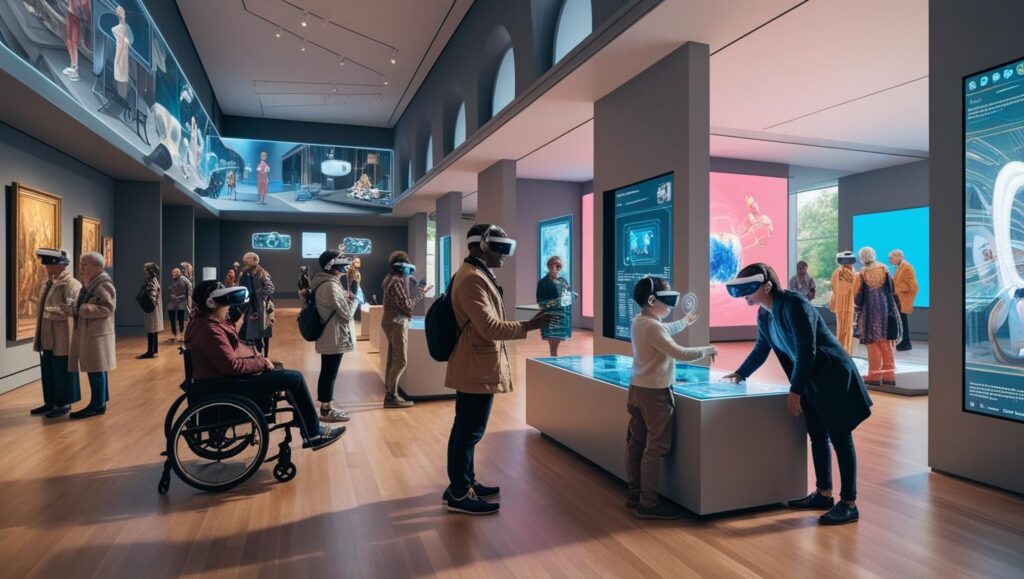Digital art exhibitions are a phenomenon that redefines the way we interact with artistic production. Through virtual platforms, these exhibitions organize collections and information in digital environments accessible via the Internet, recreating the experience of a traditional museum but with unique characteristics. By eliminating geographical and temporal barriers, they offer a new way of artistic enjoyment, allowing spectators to explore entire collections anytime and from anywhere.
Accessibility is one of the fundamental pillars of this exhibition model. Teachers, students, researchers, and art enthusiasts can access the collections of renowned museums and galleries without needing to travel physically. This democratization of access expands the reach of artworks and enables more frequent contact with art, fostering continuous aesthetic appreciation. Technologies such as virtual reality and augmented reality enhance this experience, creating immersive spaces where visitors can explore artwork details in innovative ways.
Furthermore, digital exhibitions offer unprecedented flexibility. Unlike physical museums, where space organization imposes a predetermined route, the digital environment allows non-linear navigation, enabling each visitor to construct their own journey. Multimedia elements such as videos, audio, and animations complement the experience, providing historical contexts, artist interviews, and in-depth analyses. This interactivity transforms the viewer into an active participant in the curatorial process, stimulating new readings and interpretations of the works.
Curatorship in this format plays a crucial role in organizing information and constructing the dialogue between the artwork and the public. Exhibition design, previously restricted to museum architecture, now adapts to the virtual environment, creating three-dimensional spaces and interfaces that guide the visitor’s gaze. The metaverse, for instance, emerges as a new territory for art, enabling collective experiences in immersive scenarios that expand the limits of reality.
Despite its advantages, digital exhibitions are not free from criticism. One of the main concerns is the loss of authenticity and sensory impact. Direct contact with the original artwork—its texture, scale, and materiality—is replaced by a digital reproduction that, no matter how detailed, cannot fully replicate the physical experience. Walter Benjamin’s concept of the aura of the artwork gains relevance in this debate, as digitization may distance the piece from its original context and reduce its symbolic weight.
Another significant challenge is technological accessibility. While digital exhibitions eliminate geographical barriers, they still face socioeconomic obstacles, as access to suitable devices and quality internet is not universal. Digital inequality can limit the reach of these initiatives, making them exclusive to certain groups. Moreover, digital literacy influences how content is consumed. Not all audiences are familiar with the necessary tools to navigate and fully interact with these virtual environments.
Curatorial issues are also frequently debated. In the digital universe, the overabundance of images and information can lead to knowledge fragmentation. Poorly structured exhibitions risk turning art into mere decontextualized visual content, making a more critical and in-depth appreciation difficult. The challenge lies in balancing accessibility with curatorship that maintains academic and artistic rigor, ensuring that the public has access not only to images but also to the narratives and reflections that accompany them.
The differences between these two formats do not mean that one replaces the other. On the contrary, digital and physical exhibitions can coexist and complement each other. The virtual format expands the reach and permanence of exhibitions, allowing the public to engage with a museum’s collection before or after a physical visit. Furthermore, it opens space for artistic experimentation that transcends the limits of traditional exhibition spaces.
Digital exhibitions serve as a dynamic means of making art and knowledge more widely accessible. Although they present challenges and limitations, they offer new possibilities for interaction and access to global artistic production. Whether through immersion in the metaverse, interactive navigation, or digital curation, the future of exhibitions does not lie in replacing the physical experience but in expanding the horizons of art beyond museum walls.

